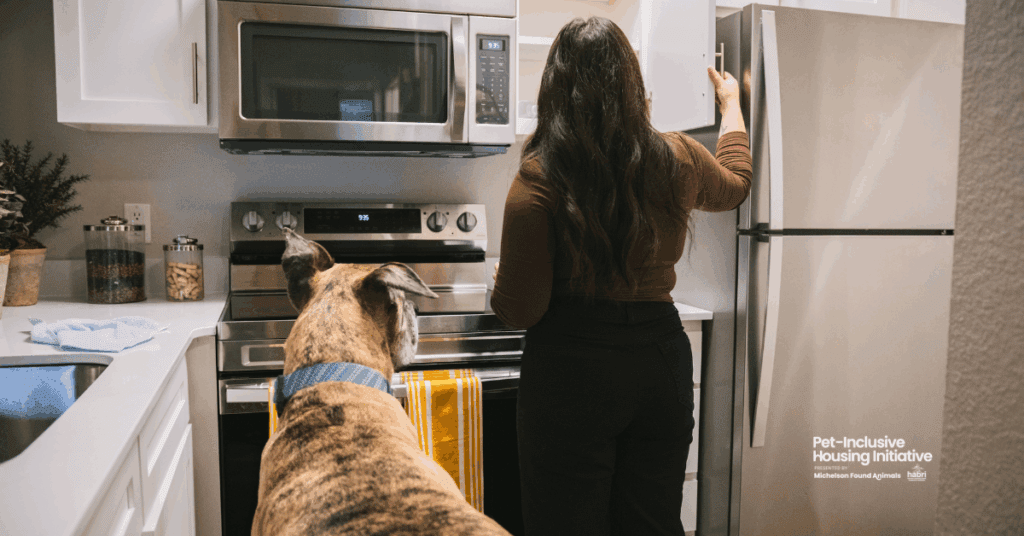
By Pet-Inclusive Housing Initiative
Reframing Pets in Multifamily Living
Across the country, pets are often treated as lifestyle add-ons — conveniences or “amenities” that justify extra fees and restrictions. Yet for roughly two-thirds of U.S. households, pets aren’t luxuries. They’re family. And when housing policies treat them otherwise, the human and financial costs ripple through communities.
A growing body of research confirms what most property managers already know in their hearts: pets are part of people’s families, and pet-inclusive policies make good business sense. In fact, 93% of owner/operators agree that pets are important members of the family, and 71% of residents — pet owners and non-owners alike — say pets help bring people together within a whole community.
So why does the rental housing industry still treat them like profit centers?
The Problem With Treating Pets Like Amenities
When property owners frame pets as “amenities,” they inadvertently put a price on family. Amenity-based pet fees and restrictions imply that a beloved companion is no different from access to a gym or a parking spot — something to be purchased, managed, and monetized.
But pets don’t just use housing — they complete homes. A renter’s relationship with their dog or cat is rooted in love, stability, and security, not luxury. Research shows that pet-inclusive housing leads to residents staying 21% longer and vacancies filling faster and more easily.
These are not signs of a burdensome “amenity.” They are hallmarks of strong, thriving communities.
When restrictive or profit-driven pet policies push families out, the consequences extend beyond the lease. In fact, housing-related issues are one of the leading causes of pet surrender to shelters, accounting for roughly 14% of owner surrenders nationwide.
Every unnecessary restriction or fee risks breaking up a family — a moral and economic loss that can be prevented through simple, humane policy changes.
What the Data Say: Inclusive Equals Accountable
Many housing providers express legitimate concerns about safety, property damage, or resident satisfaction. Fortunately, the data tell a reassuring story:
- Safety: A dog’s breed is not a predictor of behavior. Diet, training, environment, and socialization matter far more.
- Damage: According to PetScreening’s 2024 report, property managers report an average of $596 in pet damage – an amount covered by most regular security deposits – with 28% of pet-occupied units showing any damage. Meanwhile, PIHI’s 2021 report shows renters report just $210 in damage on average, and only 9% of pet-occupied units reporting any damage at all.
- Community harmony: 73% of dog owners and 49% of cat owners say their pets brought them closer to their neighbors — evidence that pets build social capital, not division.
These statistics dismantle the myths that often justify pet fees, deposits, or restrictions. As Pet-Inclusive Housing Initiative’s research shows, most fears about pets in multifamily living simply don’t match reality.
The Human and Economic Costs of Exclusion
Restrictive pet policies often carry unseen consequences — and they’re not distributed equally. Studies show that nonrefundable pet fees and breed or size restrictions disproportionately impact BIPOC and low-income renters, perpetuating cycles of inequity.
These barriers compound existing challenges for families who already face limited access to affordable housing.
Meanwhile, renters with pets are often forced into informal or unstable living arrangements, or even homelessness. The National Coalition for the Homeless estimates that up to 10% of people experiencing homelessness have a pet, and many will forgo shelter entirely rather than abandon their companion.
Pet-inclusive housing isn’t just compassionate policy — it’s a life-saving one.
The Better Way: Pets as Family, Housing as Home
When we reframe pets as family members, we unlock a cascade of benefits — for residents, communities, and housing providers alike:
- Higher resident retention and satisfaction.
- Stronger community bonds and reduced isolation.
- Reduced shelter intake and animal welfare costs.
- A larger, more motivated rental pool — since two-thirds of U.S. households include pets.
Inclusive policies don’t require landlords to give up agency. Practical tools like Pet Personality Profiles and Companion Animal Addenda allow providers to evaluate individual animals, set clear expectations, and promote accountability without resorting to outdated breed or weight limits.
A Call to Action for the Rental Housing Industry
If 93% of property owners already agree that pets are family, it’s time for policy and practice to reflect that shared truth.
Let’s retire the notion that companion animals are an amenity to be monetized — and instead embrace them as the living, loving extensions of our residents’ families that they are.
Creating pet-inclusive housing isn’t about bending to a trend; it’s about aligning business operations with the modern realities of life. When we open our doors to pets, we open them to loyalty, community, and compassion — the real cornerstones of successful multifamily living. Learn more at petsandhousing.org.
